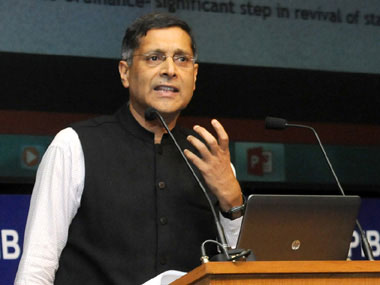New Delhi: Arvind Subramanian, Narendra Modi government’s former chief economic adviser, has deduced that India’s economic growth rate has been overestimated by around 2.5 percentage points between 2011-12 and 2016-17 due to a change in methodology for calculating GDP. India’s gross domestic product (GDP) growth rate between this period should be about 4.5 percent instead of the official estimate of close to 7 percent, he said in a research paper published at Harvard University. “India changed its data sources and methodology for estimating real gross domestic product (GDP) for the period since 2011-12. This paper shows that this change has led to a significant overestimation of growth,” he said in the paper. The paper comes amidst controversy over the country’s economic growth under the new GDP series. The revision in the methodology happened during the first term of the Modi government. “Official estimates place annual average GDP growth between 2011-12 and 2016-17 at about 7 percent. We estimate that actual growth may have been about 4.5 percent with a 95 percent confidence interval of 3.5 - 5.5 percent,” he said. [caption id=“attachment_4074559” align=“alignleft” width=“380”] File photo of Arvind Subramanian. Image courtesy: PIB[/caption] Manufacturing is one such sector where the calculations have been largely mismeasured, wrote Subramanian, who quit as the chief economic adviser in August last year before his extended tenure was to end in May 2019. He said the implication of this is: “Macro-economic policy too tight. The impetus for reform possibly dented. Going forward, restoring growth must be the highest priority, including to finance government’s laudable inclusion agenda. GDP estimation must be revisited.” Last month, official data showed that economic growth slowed down to a five-year low of 5.8 percent in January-March, pushing India behind China, due to poor showing by agriculture and manufacturing sectors. “So, post-global financial crisis, growth in India, solid not stellar,” he tweeted with a link to his research paper. “My paper focuses on original, technical methodological changes which are distinct from more recent GDP controversies such as “back-casting” and puzzling upward revisions for latest years.” He said the evidence, based on disaggregated data from India and cross-sectional/panel regressions, is robust. “Lending further credence to the evidence, part of the overestimation can be related to a key methodological change, which affected the measurement of the formal manufacturing sector. These findings alter our understanding of India’s growth performance after the global financial crisis, from spectacular to solid,” he wrote in the paper. According to Subramanian, two important policy implications follow: “the entire national income accounts estimation should be revisited, harnessing new opportunities created by the goods and services tax to significantly improve it; and restoring growth should be the urgent priority for the new government.” The BJP government had in January 2015 updated base year for GDP calculation to 2011-12, replacing the old series base year of 2004-05. Using this, in August last year the growth numbers were recalibrated by the Sudipto Mundle Committee set up by the National Statistical Commission. This dumped up growth during the Congress-led UPA years based on the so-called production-shift method. The government, however, dumped this calling the numbers experimental and not actual. It in November 2018 “recalibrated” the economy for the years 2004-05 to 2011-12, pulling down the GDP growth in UPA-era. In the period before 2011, manufacturing value added in the national accounts used to be closely correlated with the manufacturing component of the Index of Industrial Production (IIP) and manufacturing exports. However, according to Subramanian, this link has broken down. He said his analysis was based upon 17 key economic indicators for the period 2001-02 to 2017-18 with a higher interdependence with the GDP growth. “The Indian policy automobile has been navigated with a faulty, possibly broken, speedometer,” he says in the paper. In a series of tweets, he provided evidence to his theory. “Evidence 1. Growth correlations between 17 simple, macro-ish, & “independently produced” indicators and GDP break down post-2011. Pre-2011, 16 positively correlated with GDP; post-2011, 11 negatively correlated,” he said. Growth of most of these “macro-ish” indicators declines sharply post-2011 compared to pre-2011, but measured GDP growth remained broadly similar, he said citing it as evidence No. 2. “Evidence 3. In cross-country regressions, India has a normal relationship b/w growth in standard indicators and GDP pre-2011, but post-2011 it is an outlier (growth much greater than predicted by relationship). This finding–normal pre-2011, but outlier post-2011–is robust,” he said. “Evidence 4. Methodological changes affected the formal manufacturing sector in particular possibly because of issues related to deflators. Pre-2011, formal manufacturing moved normally with other indicators of manufacturing-index of production, exports-but perversely post-2011,” he added.
India’s GDP growth rate between this period should be about 4.5 percent instead of the official estimate of close to 7 percent, Arvind Subramanian said
Advertisement
End of Article


)

)
)
)
)
)
)
)
)



